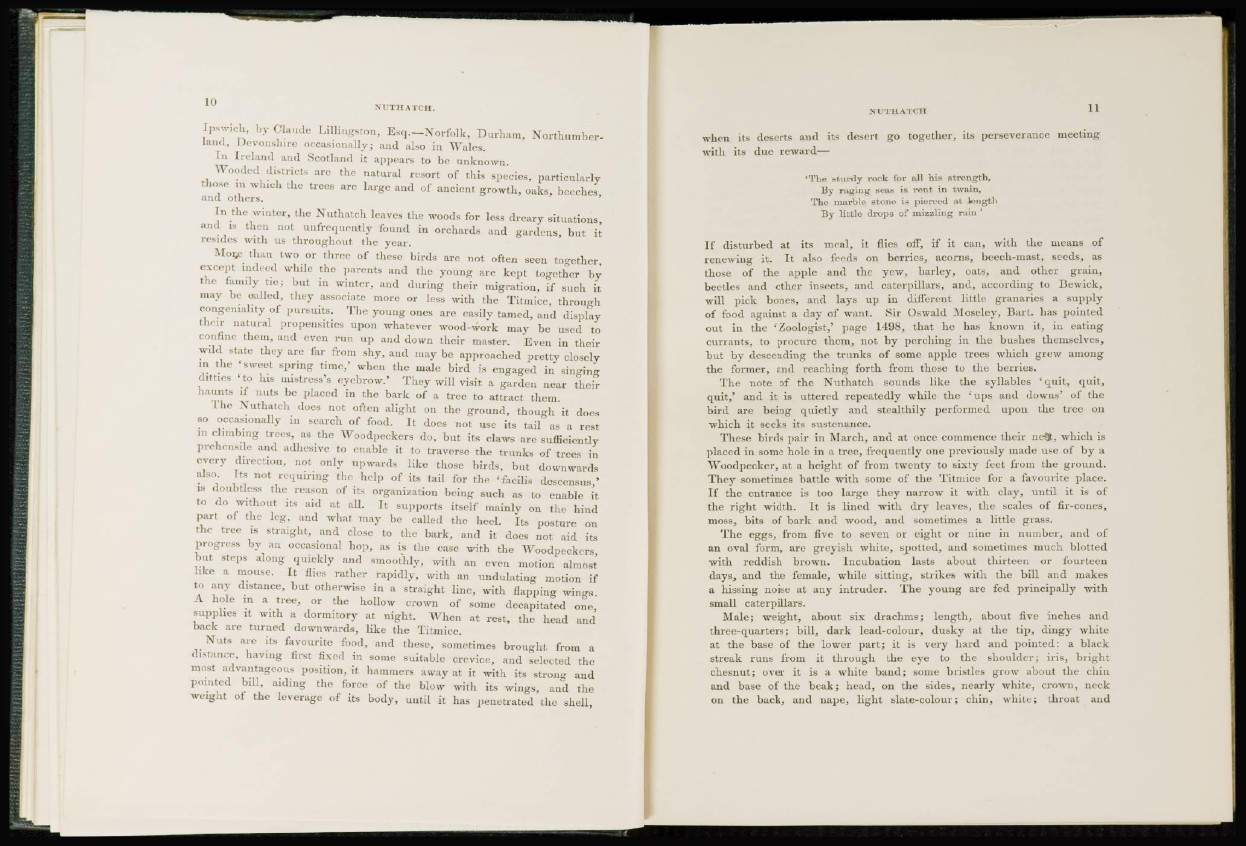
NUTHATCH.
Ipswich, by Claude Lilliugston, Esq.—Xorfblk, Durham, Northumberland,
Devonshire occasionally; and also in Wales.
In Ireland and Scotland it a p p e a r s to be unknown.
Wooded districts arc the natural resort of this species, particularly
those in which the trees are large and of ancient growth, oaks, beeches,
and others.
In the winter, the Nuthatch leaves the woods for less dreary situations,
and is then not unfrequently found in orchards and gardens, but. it
resides with us throughout the year.
Morje than two or three of these birds are not often seen together,
except indeed while the parents and the young are kept together by
the family tie; but in winter, and during their migration, if such it
may be called, they associate more or less with the Titmice, through
congeniality of pursuits. The young ones arc easily tamed, and display
their natural propensities upon whatever wood-work may be used to
confine them, and even run up and down their master. Even in their
wild state they are far from shy, and may be approached pretty closely
in the 'sweet spring time,' when the male bird is engaged in singing
ditties ' to his mistress's eyebrow.' They will visit a garden near their
haunts if nuts be placed in the bark of a tree to attract them.
The Nuthatch does not often alight on the ground, though it does
so occasionally in search of food. It does not use its tail as a rest
in climbing trees, as the Woodpeckers do, but its claws are sufficiently
prehensile and adhesive to enable it to traverse the trunks of trees in
every direction, not only upwards like those birds, but downwards
also. Its not requiring the help of its tail for the 'facilis descensus,'
is doubtless the reason of ita organization being such as to enable it
to do without its aid at all. It supports itself mainly on the hind
part of the leg, and what may be called the heel. Its posture on
the tree is straight, and close to the bark, and it does not aid its
progress by an occasional hop, as is the case with the Woodpeckers,
but steps along quickly and smoothly, with an even motion almost
like a mouse. It flies rather rapidly, with an undulating motion if
to any distance, but otherwise in a straight line, with flapping wings.
A hole in a tree, or the hollow crown of some decapitated one,
supplies it with a dormitory at night. When at rest, the head and
back are turned downwards, like the Titmice.
Nuts are its favourite food, and these, sometimes brought from a
distance, having first fixed in some suitable crevice, and selected the
most advantageous position, it hammers away at it with its strong and
pointed bill, aiding the force of the blow with its wings, and the
weight of the leverage of its body, until it has penetrated the shell,
NUTHATCH 11
when its deserts and its desert go together, its perseverance meeting
with its due reward—
'The sturdy rock for all h i s strength,
By raping seas is rent in twain,
The marble Htone is pierced at W-ngth
By liLtle drops of m i z z l i n g rain '
If disturbed at its meal, it flies off, if it can, with the means of
renewing it. It also feeds on berries, acorns, beech-mast, seeds, as
those of the apple and the yew, barley, oats, and other grain,
bet lies and other insects, and caterpillars, and, according to Bewick,
will pick bones, and lays up in different little granaries a s u p p ly
of food against a day of want. Sir Oswald Moseley, Bart, has pointed
out in the 'Zoologist,' page 1 4 9 8 , that he has known it, in eating
currants, to procure them, not by perching in the bushes themselves,
but by descending the trunks of some apple trees which grew among
the former, and reaching forth from, those to the berries.
The note of the Nuthatch sounds like the syllables 'quit, quit,
quit,' and it is uttered repeatedly while the 'ups and downs' of the
bird are being quietly and stealthily performed upou the tree on
which it seeks its sustenance.
These birds pair in March, and at once commence their ne^t, which is
placed in some hole in a tree, frequently one previously made use of by a
Woodpecker, at a height of from twenty to sixty feet from the ground.
They sometimes battle with some of the Titmice for a favourite place.
If the entrance is too large they narrow it with clay, until it is of
the right width. It is lined with dry leaves, the scales of fir-cones,
moss, bits of bark and wood, and sometimes a little grass.
The eggs, from five to seven or eight or nine in number, and of
an oval form, are greyish white, spotted, and sometimes much blotted
with reddish brown. Incubation lasts about thirteen or fourteen
days, and the female, while sitting, strikes with the bill and makes
a hissing noise at any intruder. The young are fed principally with
small caterpillars.
Male; weight, about six drachms; length, about five inches and
three-quarters; bill, dark lead-colour, dusky at the tip, dingy white
at the base of the lower part; it is very hard and pointed: a black
streak runs from it through the eye to the shoulder; iris, bright
chesnut; over it is a white baud; some bristles grow about the chin
and base of the beak; head, on the sides, nearly white, crown, neck
on the back, and nape, light slate-colour; chin, white; throat and